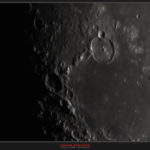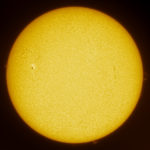Background
The Hubble Deep Field (hereon-after the HDF) is an iconic image from the Hubble Space Telescope (HST). In 1995 the HST was instructed to stare at a tiny patch of space in the constellation of Ursa Major that is almost devoid of stars and is far from the plane of the galaxy, enabling the telescope to stare out of the galaxy into the depths of the Universe. It did this for about 190 hours with a total of 340 exposures and in so doing captured some of the most distant galaxies in the Universe, some of which are an astonishing 12 billion light years away.
The HDF is located above the “bowl” of The Plough (or Big Dipper as it is called in North America) asterism in Ursa Major as can be seen in the left image above. The right image is the actual HST, a composite of red, green and blue to create a colour picture. No ground based telescope can capture such an image since the galaxies are so remote and faint that the slightest atmospheric turbulence will blur out the faint galaxies. However, the brighter members are available to ground based telescopes as we shall see later. Read more about the HDF here.
The HDF image was created with the Wide Field and Planetary Camera 2 (WFPC2) that was installed on the first Hubble servicing mission in 1993 and is an iconic instrument that created many of Hubble’s most famous images. By today’s standards its CCD sensor was tiny and comprised of three 800×800 sensors in a “L” shape. The missing top right of the image was used for the planetary section of the WFPC2 camera and just uses the bottom left quarter of the top left segment. By utilising digital manipulation techniques the four imaging quadrants could be stitched together to create a composite image. The WFPC2 was replaced by the WFPC3 in another servicing mission in 2009 that has a more modern (by 2009 standards) sensor that offers a complete image corner to corner. The WFPC2 was returned to earth and is displayed at a NASA museum.
Whilst very interesting, this is not just a pretty, semantic picture – it holds extremely important information about the early universe and the evolution of galaxies. Other Deep Field images were subsequently taken with the HST in other parts of the sky and the deep Universe looks almost identical everywhere we look, proving the cosmological principle that the Universe is essentially identical, everywhere, as a result of the Big Bang 14 billion years ago.
My Version
I took it on myself as a small project to image the Hubble Deep Field myself. Ursa Major and the HDF region is directly overhead at my location in Nottingham, UK in spring time. I downloaded the HDF coordinates from the Internet and used my TEC140 and Atik 460 CCD camera and captured 6 x 600s exposures with a luminance filter. There is no point in acquiring colour data for such remote objects. I used these to create this image:
There are many extremely remote and faint fuzzy galaxies across this entire image. I then plate solved this image in PixInsight above to give me the galaxies surrounding the HDF as indicated on the left. Note the PGC galaxies. I used these to zoom in on the Hubble Deep Field area.
Above is the HDF annotated by superimposing the HST version of the HDF and rotating and scaling it in Photoshop to match my image. You can clearly see the four brighter galaxies (about five billion light years away) and a few of the others in my image.
It is quite remarkable what amateur equipment is capable of these days!








